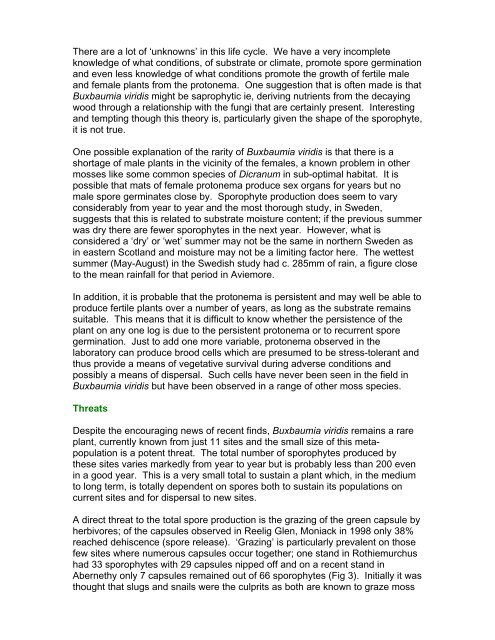Buxbaumia viridis leaflet - Plantlife
Buxbaumia viridis leaflet - Plantlife
Buxbaumia viridis leaflet - Plantlife
Create successful ePaper yourself
Turn your PDF publications into a flip-book with our unique Google optimized e-Paper software.
There are a lot of ‘unknowns’ in this life cycle. We have a very incompleteknowledge of what conditions, of substrate or climate, promote spore germinationand even less knowledge of what conditions promote the growth of fertile maleand female plants from the protonema. One suggestion that is often made is that<strong>Buxbaumia</strong> <strong>viridis</strong> might be saprophytic ie, deriving nutrients from the decayingwood through a relationship with the fungi that are certainly present. Interestingand tempting though this theory is, particularly given the shape of the sporophyte,it is not true.One possible explanation of the rarity of <strong>Buxbaumia</strong> <strong>viridis</strong> is that there is ashortage of male plants in the vicinity of the females, a known problem in othermosses like some common species of Dicranum in sub-optimal habitat. It ispossible that mats of female protonema produce sex organs for years but nomale spore germinates close by. Sporophyte production does seem to varyconsiderably from year to year and the most thorough study, in Sweden,suggests that this is related to substrate moisture content; if the previous summerwas dry there are fewer sporophytes in the next year. However, what isconsidered a ‘dry’ or ‘wet’ summer may not be the same in northern Sweden asin eastern Scotland and moisture may not be a limiting factor here. The wettestsummer (May-August) in the Swedish study had c. 285mm of rain, a figure closeto the mean rainfall for that period in Aviemore.In addition, it is probable that the protonema is persistent and may well be able toproduce fertile plants over a number of years, as long as the substrate remainssuitable. This means that it is difficult to know whether the persistence of theplant on any one log is due to the persistent protonema or to recurrent sporegermination. Just to add one more variable, protonema observed in thelaboratory can produce brood cells which are presumed to be stress-tolerant andthus provide a means of vegetative survival during adverse conditions andpossibly a means of dispersal. Such cells have never been seen in the field in<strong>Buxbaumia</strong> <strong>viridis</strong> but have been observed in a range of other moss species.ThreatsDespite the encouraging news of recent finds, <strong>Buxbaumia</strong> <strong>viridis</strong> remains a rareplant, currently known from just 11 sites and the small size of this metapopulationis a potent threat. The total number of sporophytes produced bythese sites varies markedly from year to year but is probably less than 200 evenin a good year. This is a very small total to sustain a plant which, in the mediumto long term, is totally dependent on spores both to sustain its populations oncurrent sites and for dispersal to new sites.A direct threat to the total spore production is the grazing of the green capsule byherbivores; of the capsules observed in Reelig Glen, Moniack in 1998 only 38%reached dehiscence (spore release). ‘Grazing’ is particularly prevalent on thosefew sites where numerous capsules occur together; one stand in Rothiemurchushad 33 sporophytes with 29 capsules nipped off and on a recent stand inAbernethy only 7 capsules remained out of 66 sporophytes (Fig 3). Initially it wasthought that slugs and snails were the culprits as both are known to graze moss
















